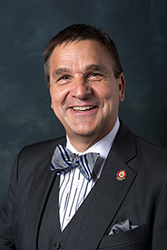SEATTLE—Vision Monday sat down with the American Optometric Association’s outgoing president, David Cockrell, OD, and incoming president, Steven Loomis, OD, during Optometry’s Meeting held here recently to discuss what’s been accomplished over the past year and what new initiatives the organization has planned.
Vision Monday: What do you see as the greatest challenges facing optometrists today?

David Cockrell, OD
Loomis: Optometry also has a lot of forces placed upon it such as the vertical integration of optical companies, which makes it difficult to know who’s in your corner and who isn’t in your corner.
Health care reform is a blessing and a curse. You have to become a part of that medical system that allows us to participate fully. That’s going to be a challenge, but it’s very doable, and I think the AOA is well positioned to do that for our members.
VM: What initiatives are being implemented by the AOA?
Cockrell: We have a very robust federal advocacy program out of our D.C. office, and that includes our Third Party Center, where we are continuously monitoring all updates coming from the federal government, whether it’s CMS or other regulatory agencies. Through those on a daily basis we publish every new update that comes out with a link, allowing optometrists to access the information and implement any changes.
Loomis: We’re also implementing a new registry from AOA, AOA MORE. It’s the first optometry registry that’s going to allow our members to have access to the merit-based incentive payment system (MIPS). So we now have a registry available free to our members where optometrists who are utilizing EHR will have a seamless way to upload the kind of information that CMS is going to require to receive incentive payments.
We really encourage members to have electronic health records. Even if they failed to implement EHR for the incentives earlier, it’s still going to be really important down the road so they can report appropriately. Just for ICD-10, I can’t imagine doing ICD-10 without electronic health records to help you navigate through that.

Steven Loomis, OD
VM: So a lot of what you’re doing is preparing optometrists to get ready for these changes?
Loomis: As the population ages, the need for medical eyecare is going up exponentially, and optometrists are well positioned to provide that care, and that’s great news. Now what we have to do is help them deliver that care in the new payment system. Our focus is to make sure they are able to deliver the care from a payment standpoint, and that’s going to require integration into a medical system. Optometry has always held that a little bit at arm’s length, not fully embracing being fully integrated into that medical system. We need to be fully integrated, and we’re helping our members do that.
Cockrell: Look at this simple evolution. I started practice in 1981. At that time, 1 percent of payments came from some form of third-party payer. Now, we’ve gone to 85 percent to 90 percent. So, we’ve gone from 1 percent to 85/90 percent, and we’ve gone from volume-based to merit-based. Your payment is going to be raised or lowered based upon the outcomes you deliver. That’s a huge change, and that’s all happening very quickly.
VM: What is the AOA doing to prepare its members to get ready for this?
Loomis: What we’ve just talked about, but also for ICD-10 for example, we have lectures coming out all the time. It’s really all about prepare, prepare, prepare, so we teach them how to prepare for ICD-10, among other things.
Cockrell: Our D.C. office staff is fully integrated into every one of the major federal regulatory agencies, so we understand in real time what’s going on. On one side we’re telling them what to do, and on the other side we have developed our Washington staff, so we’re at the point now where we can respond. We’re not reacting anymore; we’re responding.
We’re now partnering with the CDC on contact lenses. We’re able to have a level of effectiveness with a major well-recognized federal regulatory program. That didn’t used to happen with us, and now we’re a major regulatory partner and sponsor of that program.
VM: What other changes are being made?
Loomis: We’re modernizing our bylaws so that members and non-members can access information directly through AOA.org, and with only a few clicks.
Cockrell: That’s critical to keep our younger docs fully engaged. We have to engage them in the ways that they want to be reached.
Another major development is that we are going to start a significant renovation of our existing facility in St. Louis. Steve has been the chair of the building committee.
Loomis: We’re excited about it. It’s a $10 million renovation of the St. Louis facility, which was built in 1968. We’ve had some changes since 1968 but not a lot. It’s probably past time to renovate that facility.
It’s not just a facelift. It’s a gut job that will totally rebuild that facility and bring it into the 21st Century so that it reflects the needs of the association. We’ll also have space for the American Optometric Student Association, and we’ll have space for the World Council of Optometry (WCO), which is moving to St. Louis.
American optometry is considered to be the leader of the world profession of optometry, and we have a good relationship with the WCO. We feel it’s appropriate for the AOA to be involved with the WCO because we want to take that leadership role around the world. We’re developing a very close relationship with the WCO because we see it as our responsibility to the profession to lead it around the world and a great opportunity to move the profession forward.